Winter Returns
10/30/2016. Sort of, in the form of the Pleiades. After sweetening last month's M31, I saw that the cluster had cleared Meridian Pine and I thought there were worse ways to spend the hours from 2AM until dawn than collecting Pleiadean light for the first time this seaon.
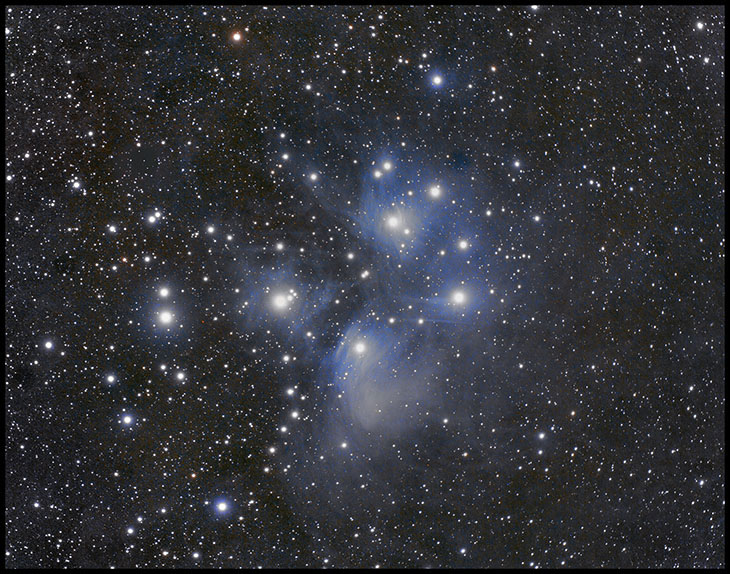
M45, the Pleiades
64x180s (3hr 12m)
TMB92SS @ F4.4
Canon 6D @ ISO 1600
Cropped. Clickable!
Not the clearest of nights, deteriorating throughout, but worth putting to some use. Drives me nuts to think what could be done with dark, clear nights.
The night actually began with a twilight Iridium flare. The iPhone app "iFlare"
predicted a flare of magnitude -3; Heavens-Above said -5. With the Sun only 3 degrees below the horizon, the difference mattered. Score one for Heavens-Above. Timing and aid d'location were perfect in both. I cooked up a method for photographing flares in such a bright sky, and the result was encouraging. Show and tell after another few for practice and refinement.
Then I literally missed with a three hour exposure of faint Sharpless 129. It was going to be a reality check anyway, but what it became was an object lesson in reading RA and Dec from Guide and entering them in the A-P controller. For my trouble, I got decent photos of a nice cluster (NGC 6939) and a bright face-on spiral galaxy (NGC 6946) next door to S129, but that was not my intent.
Last month, I got a pretty decent M31, but this night was much better. I decided to sweeten the pot, and see how well I could combine data from now and then (where "then" was before I placed an orientation scale on the telescope). Here, with a little over two hours of added exposure:
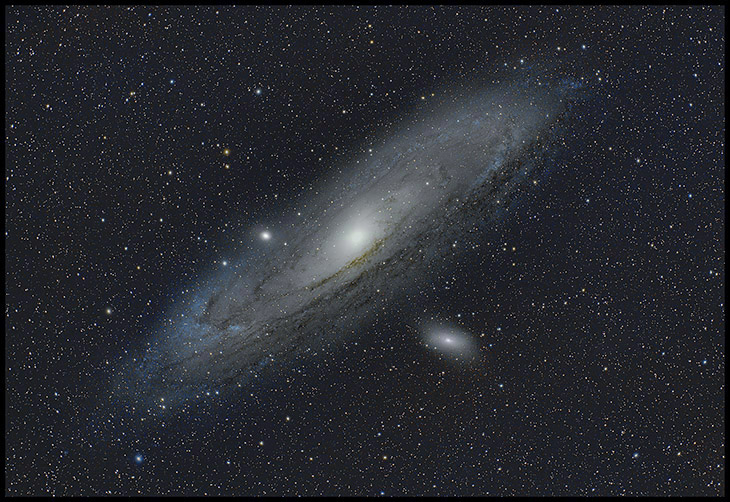
M31
84x180s (4h12m)
TMB92SS @F4.4
Canon 6D @ 1600 ISO
Yeah, you can click it.
Compare this to the former image. Note the slightly greater extent and substantially improved definition in the foreground dust lanes (more apparent in the big versions than in the previews, so get to clickin').
10/31/2016. Last night, I tried to see a brighter Iridium flare in the twilight. Heavens-Above said to expect one around -6. iFlare said, what flare? There'll be no flare. Alas, iFlare was right.
Shot S129 just for kicks. Is it in reach of an unmodified 6D from a not-very-dark site? More so than you might think, less so than I had hoped. Two hours and change show the brightest (least dim) hydrogen details. You can tell there's something there. But it's not brag-worthy. I had the 6D set for 1000 ISO rather than 1600, which matters not very much (the images are sky limited anyway). I've needed a reminder of why I should get the CCD out again. There you go.
M33 under better skies: better picture, but not better enough to use up our bandwidth showing and telling. You're welcome. Maybe next time.
About 2AM, I went out to set the 'scope up for an overnight run collecting more Pleiades data. No stars overhead. Shield eyes, still no stars. Damn. I shut down the computer; got the 'scope and camera ready to come inside; covered the mount. Then I saw plenty of stars. Not a brilliant sky, but better than some I've been pleased to have. I was fooled by my lack of dark adaptation. How long have I been doing this? Staring into a computer screen for hour after hour is apparently not the way to prepare for stargazing. I called it a night anyway.
'Tis the season: and I don't mean Halloween, though it is. I set the SBIG CCD up for imaging. Which means I extracted it from the case where it's spent our hazy summer, plugged everything up, discovered that the drivers had not been installed on the latest telescope-control computer, installed them, found the license for Maxim DL5 and installed that, introduced the CCD to the software, told Maxim the sequence of filters in its color filter wheel (Luminance, Clear, Blue, Green, Red, Ha, Oiii, Sii, empty, empty), and set up autosequences for luminance, Ha, Oiii, LRGB, focusing, composing, etc.
Then I took enough shots to see that frost is once again an issue. Not a surprise but still a nuisance. Once a year or so, the CCD chamber needs to be purged. I looked down the throat of the camera with an empty filter slot selected and got a good look at the rimed cover glass. The chip was chilled to -15C while sitting in a +73F room (so I know the Peltier cooler is working just fine). I baked the dessicant plug for 4 hours at 375F, finishing with half an hour or so at 400F. Removed it from the oven, placed it in a sealed container with additional fresh desiccant to rest. Served cool. In a day or two, it should be ready to use. [24 hours on: Just checked and all looks good at -18C which is as low as the cooler could go in a 72F room. Cleaned the filters' sky-sides while I was at it. Later, under the twilight sky, no, I still see some moisture. Patience, Grasshopper...]
I'll have to play spacing-the-flattener games again. From working with the Canons behind the TMB, the optimum spacing is no longer mysterious. The EOS flange distance is 44.0mm and with the TRF-2008 compressor / flattener on a 9.7mm thick T-ring the correction is pretty good (see recent examples). So match that spacing: 44.0 + 9.7 = 53.7mm. The Orion flattener wants to be mounted 66mm ahead of the sensor (also empirically determined).
The ST2000XM / CFW-10 has a casually measured "flange distance" (from the front of the CFW-10 to the sensor) of 34mm (33.5mm by the OEM's specs). Screwing either the TeleVue or Orion flattener directly into the face of the CFW-10 would put the corrector too close to the sensor. We need to replicate the Canon's spacing as nearly as possible, but since we're only using the inner thimble-ful of the field (compared to the ginormous 6D sensor), tolerances should be much less stringent. Says so right here.
The Televue flattener / compressor will need this much extra spacing: 53.7 (the desired spacing) - 33.5 (distance of the sensor behind the CFW-10's face plate) = 20.2mm by the book or 53.7-34 = 19.7mm by the micrometer. It sure would be nice to have a 20mm extension ring. Oh, look: I has one!
For the Orion flattener: 66.0 - 33.5 = 32.5mm. I have a 30mm ring. And since we're only using the central filet of the field, that might be close enough. (Also, adding a couple of mm's is easier than removing them, so if you're going to be off, be off that way.)
As for the AT10RC, it works well with no corrective optics. The adapter to put the TMB92's 3-inch Feathertouch focuser behind the R-C should allow it to work even better. Changing the endcap to put the A-P compressor behind the R-C should be routine --it's a well documented combination-- but let that wait until the rest is nailed down.
Now to turn a cap on the lathe to seal the OTA when the focuser is off one 'scope playing on the other. O, the joy, metal whittling! I mean that.
11/01/2016. The CCD is back in business. I'm using it at a very high temperature (+1F) because the sensor chamber is not entirely dried out. I took a few short exposures of M57 to measure curvature (16%, no problem) and plate scale, and then set it to taking an LRGB sequence of the Crescent Nebula.
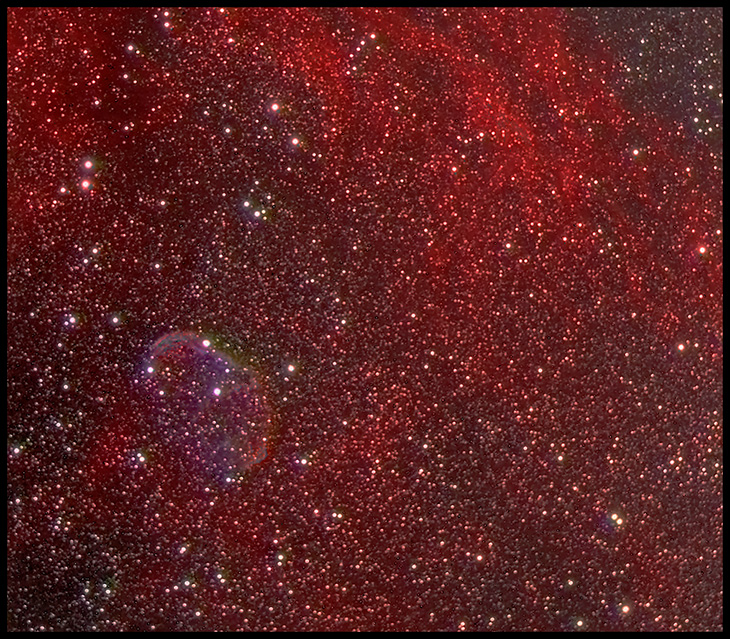
NGC 6888
Slightly whack hybrid: color from the 50D a few night's back using H-a and O-III
filters combined with luminance from the CCD. Call it a proof of concept.
I'm going to need to rework the orientation scale currently on the flattener. Put it on the TMB tailpiece instead as it is done now on the R-C's stock focuser (not least because this focuser will soon be shared with the R-C). Otherwise, you'll be all the way back to the bad old days of wondering where the hell a guidestar could be.
Some basic usage notes: With the field flattener / telecompressor in place ahead of 10mm of extension tubes, the ST2000XM/CFW10 came to focus with the focuser cranked out to about 44mm. Orienting the camera so that power and data cables come off to the right lines up the long axis of the chip E/W. It's a start.
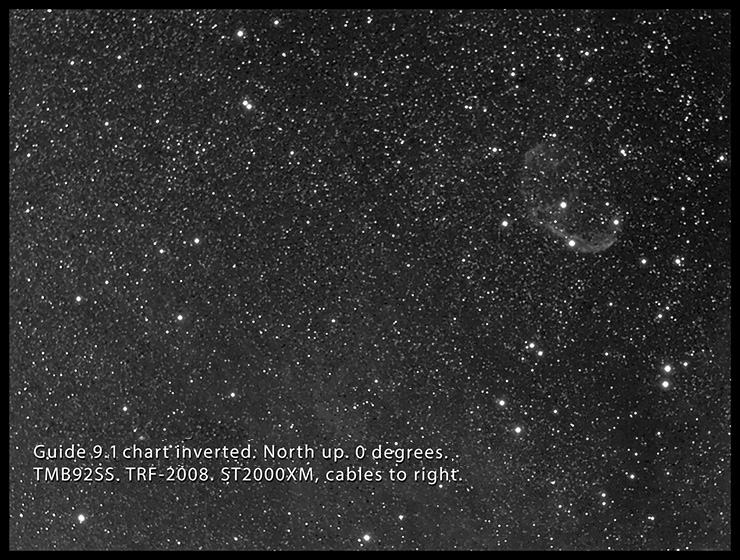
NGC 6888
11x300s L filter, ST2000XM
TMB92SS @ F4.4
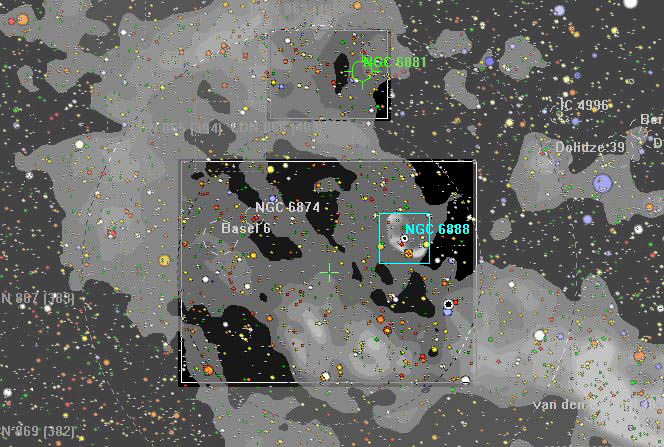
The corrector and spacing are OK --images are sharp-- but after so much time working with the Canons, I'm astonished that the results are not deeper and better than they are. I did a dozen 300s luminance frames of NGC 6888 and tossed in a few RGB frames for giggles. Tracking was solid. The sky was indifferent. Now, it's true that I was using the CCD at a warm +1F and that I was shooting in white light and through broadband color filters, and I've recently shot the same subject with the 50D through a 7nm H-a filter for 2.5x as long. So, maybe this is apples and oranges, or maybe I stacked the deck as well as the images (pick your metaphor) against the CCD. Even so, the Canons are holding their own. I'll give the CCD a better chance next time out (more cooling, better calibration, use the superpowers in its filterwheel).
This also suggests that it's going to be fun to see what the the 6D and modded 50D can do behind the Ritchey.